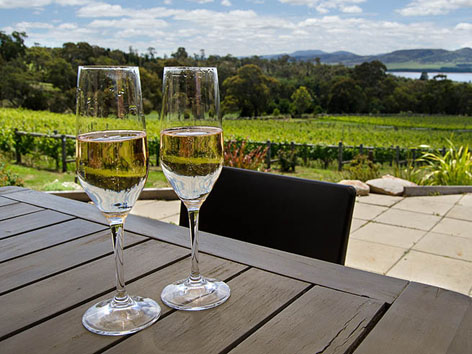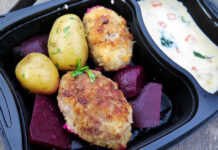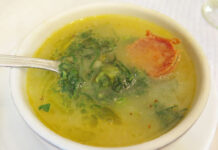<< back to foods in Hobart, Tasmania

What: Let’s face it: Until the 1950s, Tasmania was a brewer’s playground, with beer being the alcoholic beverage of choice since the convict days in the 1700s. Thankfully, a migrant with an eye for detail and a nose for wine noticed how closely the terroir and climate matched that of Europe. Fast-forward 70 years and Tasmania now basks in global recognition for its cool-climate white and red wines: pinots, rieslings, chardonnays, and more. It is no exaggeration to say that its sparkling varieties even rival those of Champagne. With companies such as Roederer and Moët et Chandon sourcing grapes from Tasmania, you know they must be doing something right!
Where: Luckily for travelers, the Hobart region around southern Tasmania is one of the state’s best for fine wines. “High quality, low volume” is the catchphrase, and you don’t need to travel far to experience this for yourself.
If you are tight on time, Moorilla Estate (651-655 Main Rd., map) is only minutes away from central Hobart, on the broad banks of the Derwent River. If you can drag yourself away from the adjacent Museum of Old and New Art (MONA) long enough, you’ll find an excellent selection of ultra-premium small-batch wines at its cellar door.
If possible, though, you really should dedicate a couple of days or more to your grape explorations. To the north in the Coal River Valley, you’ll find Puddleduck Vineyard (992 Richmond Rd., map), home of the “Reverse BYO”—buy a wine and bring your own food for a picnic on the grass or by the lake—and Domaine A, which, despite the cool climate, has proven the naysayers wrong with its acclaimed range of refined cabernet sauvignons. There’s also Coal Valley Vineyard (pictured above; 257 Richmond Rd., Cambridge, map), the perfect place on a warm summer day to relax with a glass of its exceptional pinot noir and take in the magnificent views of the Coal River Valley.
To the north of Hobart, west and further up the Derwent Valley is Stefano Lubiana Wines (pictured above; 60 Rowbottoms Rd., map) and its delicious sparkling whites (an absolute must in summer). And then to the south you could spend weeks exploring the nooks and crannies of the Huon Valley, with Home Hill (38 Nairn Rd., map) consistently producing award-winning and extremely approachable pinots, for which Tasmania is renowned.
When: Check individual winery websites for hours of operation. Pictured, the Coal Valley Vineyard cellar door is open for tastings daily, 11am-5pm (full lunch is available from 11am-3pm, with a smaller cellar door menu available from 3pm-4pm).
Order: Taste the wine, or buy the wine! Pictured is a vintage sparkling pinot noir-chardonnay blend. Due to its popularity, this blushing beauty is no longer available, but you can secure a bottle of its younger sister, the 2013 blanc de noir, made from 100% pinot noir grapes (AU$44). With delicate strawberries on the tongue and hints of brioche on the nose, that wine is just as sure to please.
As at most Tasmanian wineries, tastings are complimentary with the purchase of any bottle, or $5 without a purchase (tasting prices may vary across vineyards). A seated tasting flight of four wines can be arranged at $15 per person.
Alternatively: Instead of designating a driver for the day, consider a wine tour. Drink Tasmania offers half-day and full-day tours to all the southern wine regions, for groups of two to 13 people. Gourmet food tastings and lunches are available for some tours as well.
Or, if you’re on your feet you can easily drop by Cool Wine in central Hobart, where you’ll find one of the most extensive ranges of local wines and an extremely knowledgeable staff that loves helping out visitors in making the perfect wine selection. Tastings of not only wines but also spirits, beers, and ciders are often available—check its Facebook page for upcoming events.
Good to know: Normally held on the first weekend of March, the Southern Vineyards Open Weekend (details are posted here in the weeks prior) is the rare chance to taste lots of Tasmania’s wines that aren’t easily accessible to the public. Many of the state’s best wineries are small and unable to justify an open cellar door year-round. But once the harvest is over, on this one special weekend per year, they all open their doors, providing wine lovers with a unique opportunity.













